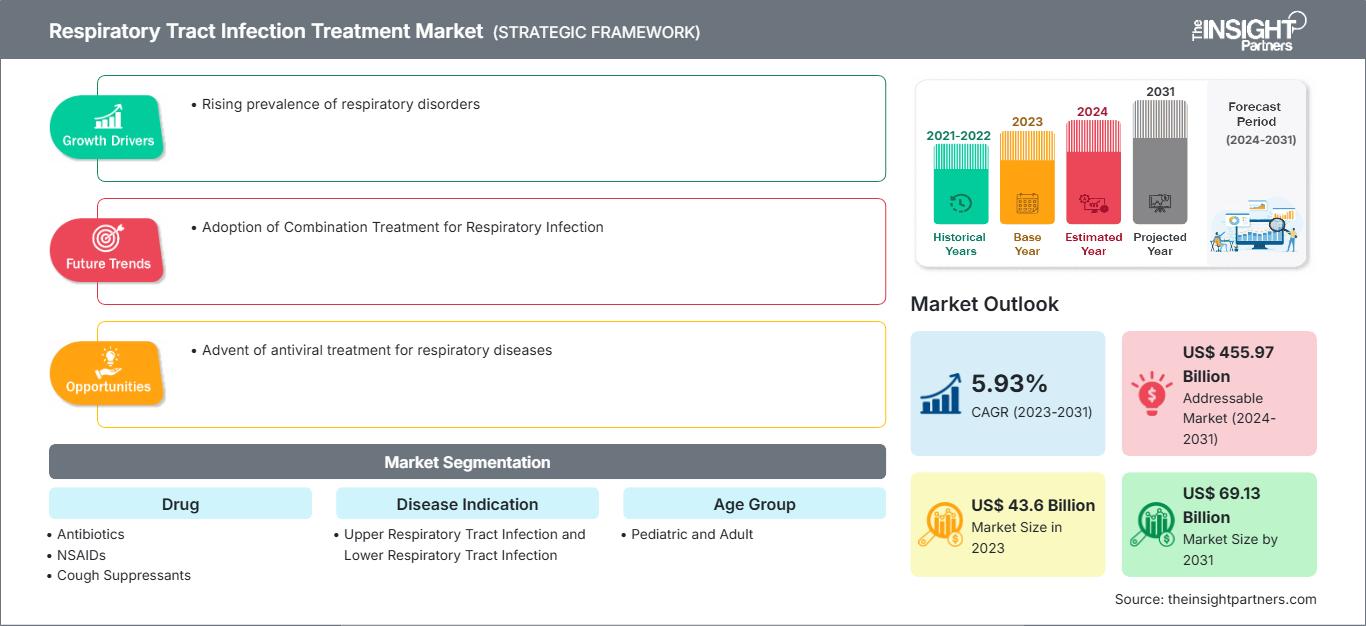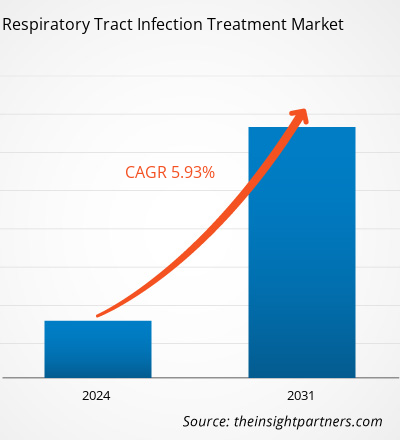호흡기 감염 치료 시장 규모는 2023년 436억 달러에서 2031년 691억 3천만 달러로 성장할 것으로 예상되며, 2023년부터 2031년까지 연평균 성장률 5.93%를 기록할 것으로 예상됩니다.
호흡기 감염(RTI)은 부비동, 인후, 기도 또는 폐의 감염입니다. 세계 호흡기 감염 치료 시장 보고서는 시장을 주도하는 주요 요인을 강조하고 주요 기업들의 성장세를 보여줍니다. 시장 성장을 주도하는 주요 요인으로는 전 세계적으로 호흡기 감염 유병률 증가, 호흡기 감염 및 다양한 치료법에 대한 인식 제고, 호흡기 감염 치료 관련 임상 시험 증가 등이 있습니다. 그러나 호흡기 치료제 및 호흡기 감염 약물 관련 부작용에 대한 연구 부족은 시장 성장을 저해하고 있습니다. 또한, 항바이러스 치료제의 등장으로 향후 몇 년 동안 전 세계 호흡기 감염 치료 시장에 새로운 트렌드가 나타날 것으로 예상됩니다.
성장 동력 및 제약:
노인 인구의 호흡기 질환 진단 수요 증가
전 세계적으로 노인 인구가 증가함에 따라 향후 몇 년 동안 호흡기 질환 진단 수요가 증가할 것으로 예상됩니다. 예를 들어, 2021년 11월 British Journal of Pharmacology에 발표된 논문에 따르면, 영국 인구의 약 1%가 매년 지역사회 획득 폐렴(CAP) 진단을 받습니다. 65세 이상에서 약 70%의 사례가 발생하며, 이 연령대의 30일 사망률은 약 20%입니다. 따라서 고령 인구 증가와 CAP(폐렴)과 같은 질병 발생률 증가는 호흡기 질환 치료제 수요를 촉진하여 전체 시장 성장을 촉진할 것으로 예상됩니다. 이 분야의 지속적인 연구 개발은 다양한 진단 검사 및 시술 개발로 이어져 향후 시장 성장에 긍정적인 영향을 미칠 것입니다. 혁신적인 진단법은 예측 기간 동안 시장 발전에 좋은 기회를 제공할 것으로 예상됩니다. 그러나 호흡기 감염 치료제 관련 연구 부족 및 부작용은 전 세계 호흡기 감염 치료제 시장 성장을 제한할 것으로 예상됩니다.
이 보고서의 일부, 국가 수준 분석, Excel 데이터 팩을 포함하여 모든 보고서에 대한 사용자 정의를 무료로 받을 수 있을 뿐만 아니라 스타트업 및 대학을 위한 훌륭한 제안 및 할인을 이용할 수 있습니다
호흡기 감염 치료 시장: 전략적 통찰력

-
이 보고서의 주요 주요 시장 동향을 확인하세요.이 무료 샘플에는 시장 동향부터 추정 및 예측에 이르기까지 데이터 분석이 포함됩니다.
보고서 세분화 및 범위:
세계 호흡기 감염 치료 시장 분석은 약물 질환 적응증, 투여 경로, 연령대 및 유통 채널을 고려하여 수행되었습니다. 약물을 기준으로 시장은 항생제, NSAID, 기침 억제제, 비충혈 완화제 등으로 구분됩니다. 질병 적응증별로는 세계 호흡기 감염 치료 시장을 상기도 감염과 하기도 감염으로 구분합니다. 투여 경로 측면에서는 경구용과 비경구용으로 구분됩니다. 연령대를 기준으로 시장은 소아용과 성인용으로 구분됩니다. 유통 채널을 기준으로 전 세계 호흡기 감염 치료 시장은 병원 약국, 온라인 약국, 그리고 소매 약국으로 구분됩니다.
세분화 분석:
의약품 부문에서는 항생제 부문이 2023년 세계 호흡기 감염 치료 시장 점유율 1위를 차지했습니다. 이 부문은 2023년부터 2031년까지 가장 높은 연평균 성장률(CAGR)을 기록할 것으로 예상됩니다. 호흡기 감염은 기관지염, 폐렴, 부비동염 등 다양한 질환을 포함하며, 종종 세균성 병원균에 의해 발생합니다. 항생제는 이러한 유해 세균을 표적으로 삼아 제거함으로써 염증을 줄이고 빠른 회복을 촉진합니다. 호흡기 감염에 일반적으로 처방되는 항생제에는 페니실린, 세팔로스포린, 마크로라이드, 플루오로퀴놀론, 테트라사이클린 등이 있으며, 이들 각각은 고유한 작용 기전과 박테리아 표적을 가지고 있습니다.
질병 적응증을 기준으로 볼 때, 하기도 감염 부문은 2023년에 더 큰 시장 점유율을 기록했습니다. 2023년부터 2031년까지 더 높은 연평균 성장률(CAGR)을 기록할 것으로 예상됩니다. 하기도 감염(LRTI)은 폐와 기관지에 영향을 미치는 감염으로, 일반적으로 박테리아, 바이러스 또는 진균 병원균 등에 의해 발생합니다. 폐렴, 기관지염, 세기관지염과 같이 일반적으로 가래가 많은 기침, 흉부 불편감, 호흡 곤란, 발열 등의 증상을 나타내는 질환은 LRTI로 분류됩니다. 중증 폐질환(LRTI)인 폐렴은 폐 조직의 염증 및 감염을 수반하여 폐 경화(폐의 일부 영역 또는 장기 전체)와 가스 교환 장애를 유발합니다. 투여 경로별로는 경구 부문이 세계 호흡기 감염 치료 시장에서 더 큰 점유율을 차지했으며, 2023년부터 2031년까지 더 높은 연평균 성장률(CAGR)을 기록할 것으로 예상됩니다. 아목시실린, 아지트로마이신, 독시사이클린과 같은 경구 항생제는 호흡기 감염을 유발하는 세균성 병원균을 퇴치하기 위해 자주 처방됩니다. 항생제 외에도 경구 코르티코스테로이드는 중증 천식이나 만성 폐쇄성 폐질환(COPD) 악화 시 염증을 완화할 수 있습니다. 오셀타미비르와 같은 경구 항바이러스제는 인플루엔자와 같은 바이러스성 호흡기 감염 치료에 사용됩니다. 경구 투여의 일반적인 장점은 투여의 용이성, 환자 순응도, 그리고 전신 약물 분포입니다. 연령대별로는 성인 부문이 2023년 세계 호흡기 감염 치료 시장에서 더 큰 점유율을 차지했습니다. 소아 부문은 2023년부터 2031년까지 더 높은 연평균 성장률(CAGR)을 기록할 것으로 예상됩니다. 소아 호흡기 감염의 조기 진단 및 치료의 중요성에 대한 인식 제고와 치료에 사용되는 호흡 기기의 발전과 같은 요인들은 새롭고 더욱 효과적인 치료 옵션 개발을 이끌고 있습니다. 또한, 예방 의료에 대한 관심 증가는 소아 부문 시장 성장에 기여하고 있습니다. 유통 채널 측면에서는 병원 약국 부문이 2023년부터 2031년까지 상당한 시장 점유율을 차지할 것으로 예상됩니다. 병원 약국은 의료 시스템의 핵심 구성 요소로서, 특히 정맥 또는 근육 내 약물 투여가 필요한 급성 및 중증 호흡기 감염 관리에 중요한 역할을 합니다. 이러한 약국은 항생제, 항바이러스제, 코르티코스테로이드 및 기타 호흡기 감염 치료제를 조달, 보관 및 분배하고 병원의 입원 및 외래 환경에 안전하고 시기적절하게 배송하는 일을 담당합니다.
호흡기 감염 치료
호흡기 감염 치료 시장 지역별 통찰력The Insight Partners의 분석가들은 예측 기간 동안 호흡기 감염 치료 시장에 영향을 미치는 지역별 동향과 요인을 면밀히 분석했습니다. 이 섹션에서는 북미, 유럽, 아시아 태평양, 중동 및 아프리카, 그리고 중남미 지역의 호흡기 감염 치료 시장 부문 및 지역별 현황도 다룹니다.
호흡기 감염 치료 시장 보고서 범위
| 보고서 속성 | 세부 |
|---|---|
| 시장 규모 2023 | US$ 43.6 Billion |
| 시장규모별 2031 | US$ 69.13 Billion |
| 글로벌 CAGR (2023 - 2031) | 5.93% |
| 이전 데이터 | 2021-2022 |
| 예측 기간 | 2024-2031 |
| 다루는 세그먼트 |
By 약물
|
| 포함된 지역 및 국가 |
북미
|
| 시장 선도 기업 및 주요 회사 프로필 |
|
호흡기 감염 치료 시장 참여자 밀도: 비즈니스 역학에 미치는 영향 이해
호흡기 감염 치료 시장은 소비자 선호도 변화, 기술 발전, 그리고 제품 효능에 대한 인식 제고 등의 요인으로 인한 최종 사용자 수요 증가에 힘입어 빠르게 성장하고 있습니다. 수요가 증가함에 따라 기업들은 제품 라인업을 확장하고, 소비자 니즈를 충족하기 위한 혁신을 추진하며, 새로운 트렌드를 적극 활용하고 있으며, 이는 시장 성장을 더욱 가속화하고 있습니다.

- 을 얻으세요 호흡기 감염 치료 시장 주요 주요 플레이어 개요
지역 분석:
호흡기 감염의 조기 진단 및 치료의 중요성에 대한 대중의 인식이 높아짐에 따라 향후 몇 년간 세계 호흡기 감염 치료 시장 성장에 기여할 것으로 예상됩니다. 시장은 북미, 유럽, 아시아 태평양, 중동 및 아프리카, 그리고 중남미로 구분됩니다. 북미는 2023년 세계 호흡기 감염 치료 시장 점유율 1위를 차지했습니다. 북미 시장은 국내 호흡기 감염 유병률 증가로 인해 상당한 성장을 경험하고 있습니다. 대기 오염, 흡연, 인구 밀집 지역 등의 요인이 북미의 호흡기 감염 발생률 증가에 기여하고 있습니다. 호흡기 감염 유병률 증가, 의료에 대한 인식 제고, 그리고 정부의 우호적인 정책이 세계 호흡기 감염 치료 시장 성장을 견인하고 있습니다.
경쟁 환경 및 주요 기업:
세계 호흡기 감염 치료 시장 전망은 이해관계자들이 성장 전략을 수립하는 데 도움이 될 수 있습니다. Abbott Laboratories, AstraZeneca plc, Alembic Pharmaceuticals Ltd., Boehringer Ingelheim International GmbH, GlaxoSmithKline plc, Teva Pharmaceutical Industries Ltd, Novartis AG, F. Hoffmann-La Roche AG, Sanofi SA, Merck & Co., Cipla 등이 세계 호흡기 감염 치료 시장 보고서에 포함된 주요 기업입니다. 이들 기업은 급증하는 소비자 수요를 충족하고 특수 포트폴리오의 제품 범위를 확장하기 위해 다양한 전략(유기 및 무기 전략 모두 포함)에 집중하고 있습니다. 시장에서 기업들이 채택한 주요 전략에는 신기술 출시, 기존 제품 개발, 지리적 확장이 포함됩니다.
- 과거 분석(2년), 기준 연도, CAGR을 포함한 예측(7년)
- PEST 및 SWOT 분석
- 시장 규모 가치/거래량 - 글로벌, 지역, 국가
- 산업 및 경쟁 환경
- Excel 데이터세트
최근 보고서
사용 후기
구매 이유
- 정보에 기반한 의사 결정
- 시장 역학 이해
- 경쟁 분석
- 고객 인사이트
- 시장 예측
- 위험 완화
- 전략 기획
- 투자 타당성 분석
- 신흥 시장 파악
- 마케팅 전략 강화
- 운영 효율성 향상
- 규제 동향에 발맞춰 대응






















 무료 샘플 받기 - 호흡기 감염 치료 시장
무료 샘플 받기 - 호흡기 감염 치료 시장